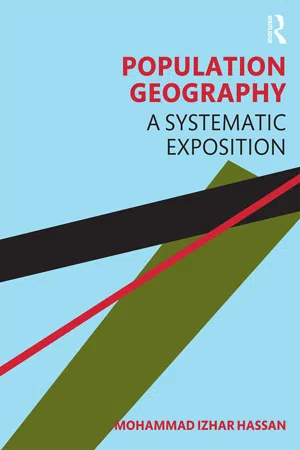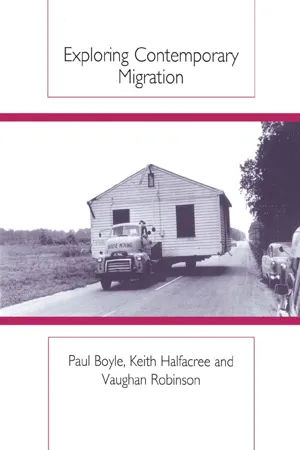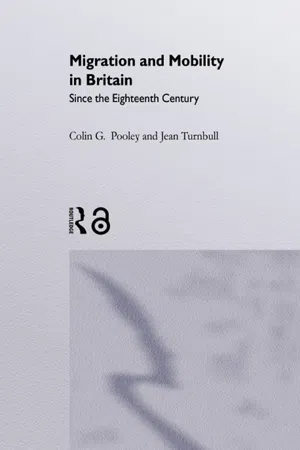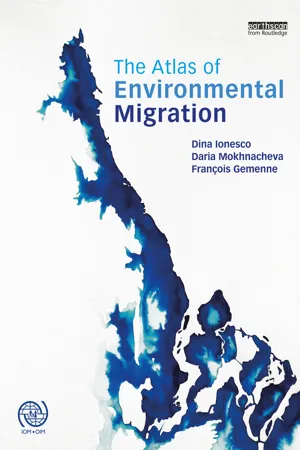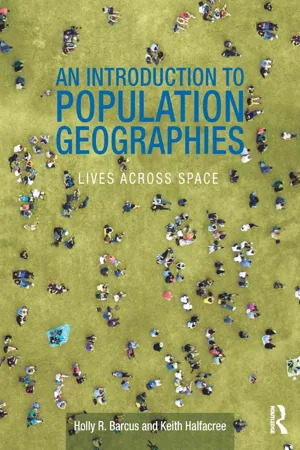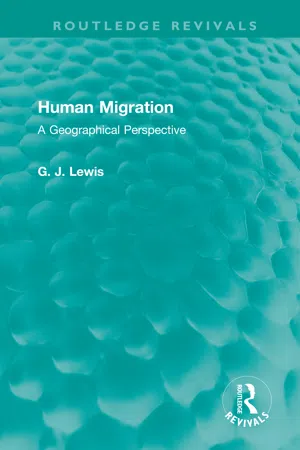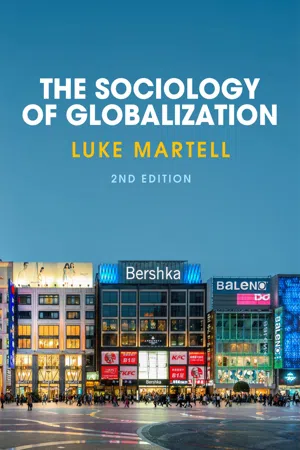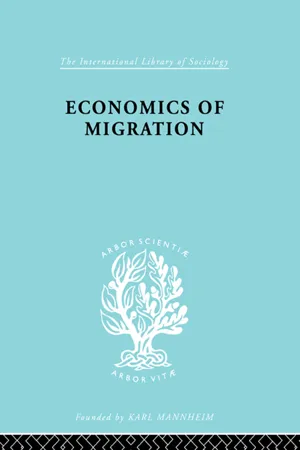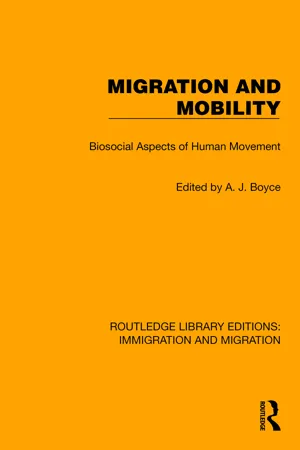Geography
Effects of Migration
The effects of migration refer to the social, economic, and cultural impacts resulting from the movement of people from one place to another. These effects can include changes in population demographics, labor markets, and cultural diversity. Migration can also lead to both positive and negative consequences for both the sending and receiving communities, influencing factors such as economic development and social cohesion.
Written by Perlego with AI-assistance
Related key terms
Related key terms
1 of 4
Related key terms
1 of 3
11 Key excerpts on "Effects of Migration"
- eBook - ePub
Population Geography
A Systematic Exposition
- Mohammad Izhar Hassan(Author)
- 2020(Publication Date)
- Routledge India(Publisher)
United Nations Multilingual Demographic Dictionary defines migration as ‘a form of geographical or spatial mobility between one geographic unit and another, generally involving a change in residence from the place of origin or departure, to the place of destination or arrival’. Thus, migration is different from other forms of mobility such as temporary movement of tourists, or frequent trips of people in business, or constant movements of nomads, or movement of students for the purpose of studies, or daily movement of commuters to place of work. These movements do not involve any permanent or semi-permanent change in the place of residence to qualify as migration.The study of migration occupies an important place in population studies, as together with fertility and mortality, migration determines the size, distribution and growth of population along with its composition and characteristics. As compared with the other two components, migration has been a more popular subject of interest for population geographers. Interestingly, demographers have paid very little attention to this component of population change. Population geographers have since long been concerned with the relationships between movement of people, distance and interacting areas (Woods, 1979:165). Along with its various demographic, social and economic effects, population geographers have also been concerned with the environmental influences upon migration streams and consequences in areas of departure and destination (Clarke, 1972:130).Mobility and migration: general terms and concepts
As noted previously, migration refers to permanent or semi-permanent change in the place of residence of an individual or a group of individuals from one location to another. Hence, it is different from the more general term mobility, which refers to all types of movements of people (Rubenstein and Bacon, 1990:75). Thus, the term mobility includes both permanent (and semi-permanent) and temporary movements of people over the earth. With regard to temporary movements, the examples of which have already been cited, a distinction is generally made between a cyclic and a periodic movement. A cyclic movement includes short duration trips to place of work (i.e. commuting), or frequent business trips of people in business, or movement of nomads, which is comparatively irregular in timing. A periodic movement, on the other hand, involves a longer period of residence away from home base than that in the cyclic movement (Blij and Muller, 1986:103). Periodic movement includes the movement of students away to other locations for the purpose of studies, or the movements of military personnel to military bases, training schools or combat zones. The movement of migrant labourers and their families is also periodic movement, although it is more cyclic than that of students or military personnel. Still another form of periodic movement is what is commonly known as transhumance - eBook - ePub
- Paul Boyle, Keith Halfacree, Vaughan Robinson(Authors)
- 2014(Publication Date)
- Routledge(Publisher)
psychological appreciation of migration. For example, for the migrant, the act of moving can promise much and/or can be a highly stressful and disruptive experience. For international migrants especially, migration is frequently associated with leaving a familiar home environment and the often disquieting experience of settling into a culturally very different place. New horizons can be reached as former lives are left behind, with all the existential rewards and traumas that such a change can bring.• The economic impacts of migration are also immense, especially as economic considerations underpin such a high percentage of migration flows. Although it is impossible to provide precise estimates, international labour migrants are believed to remit over $67 billion annually to their homelands, making this second only to oil in world trade figures (Martin 1992). Certain national economies rely heavily on these remittances and actively encourage short-term emigration. In contrast, in other nations immigrants are frequently unfairly blamed for high unemployment levels.• Migration also has considerable political significance, both on the world stage and domestically. The reunification of Germany, the Zionist-inspired repopulation of Israel, the arrival of thousands of Vietnamese boat people in Hong Kong, and the illegal migration of Mexican workers into the United States across the Rio Grande all involve migration events that have had considerable political impacts. Migration issues form a central aspect of the contemporary political scene, both at the domestic and at the international scale.• Finally, we can return to focus on migration as a spatial - Colin Pooley, Jean Turnbull(Authors)
- 2005(Publication Date)
- Routledge(Publisher)
The central question to be addressed in this chapter can be put very simply: did migration matter? This question can be explored by focusing on the impact on individual people and their families, on the places that migrants left and went to, and on change within the wider structures of economy and society. The main difficulty in examining links between migration and social and economic change at either the individual or societal level relates to the issue of causation. The fact that migration was occurring at a time of economic change in a particular region, or of turmoil in the lives of individual migrants, does not mean that the events were necessarily related. Even if there was a relationship the nature of causation is not always clear. For instance, was migration a response to forces of change operating within society as a whole, or was the process of migration itself an agent of change? Did an individual move because of major difficulties or changes in their circumstances, or did the act of migration itself create new problems and fundamentally change people’s lives?There are, of course, no simple answers to such questions, and in many instances a whole host of causes and effects will have been closely interrelated. Disentangling these for the more distant past may be an impossible task. The aim of this chapter is to use both the longitudinal migration data and evidence from diaries and life histories provided by family historians to begin to explore some of the impacts of migration on individuals, places and wider society. This is achieved by, first, examining the impacts of short distance and long distance mobility, suggesting that the impacts of these events would have been rather different. Second, the impact of migration on places is assessed by reviewing evidence from the aggregate data set for links between migration and processes of local and regional change. Third, the extent to which the meaning of migration, and its links to other processes of change, varied over time is explored by focusing on four cohorts of migrants with similar characteristics to examine the extent to which parallel processes were operating at different periods of time. It is obvious that historical events assume much greater significance if they had an impact on and meaning for the people involved, and if they were related to the broader processes of change that were taking place within society. Because of the volume of migration in the past, and its potentially disruptive effects in moving people from one part of the country to another, it is usually assumed that migration had such significance. This chapter explores this proposition in detail drawing on evidence provided by family historians.- eBook - ePub
- Dina Ionesco, Daria Mokhnacheva, François Gemenne(Authors)
- 2016(Publication Date)
- Routledge(Publisher)
The increasing incidence of some of these environmental threats is attributable to the very progress humanity has accomplished since the Industrial Revolution, Climate change constitutes one of the greatest challenges humanity will have to face, as it calls into question the economic and lifestyle choices our society has made, by threatening our very survival as a species. We have no other choice but to try to reduce our impact on the environment, and to adapt to some of the irreversible changes we have caused, or face increasing social and economic costs and damage. Migration will inevitably be part of this picture, either as a social and human cost of inaction or restrictive policies, or as a positive strategy to reduce risks and people's vulnerability, if we make the right political and economic choices. Good migration management can be part of the solution, together with sound environmental and sustainable development policies.Part 2 of the Atlas delves into the complex interaction between environmental phenomena, human society and migration, presents various sudden-onset events and slow-onset processes, natural or human-made, which affect the planet's population, and looks into the mechanisms through which environmental factors affect human mobility. A special focus is placed on climate change, the effects of which are often poorly discerned from other environmental phenomena. Environmental migration is then discussed within the wider context of the traditional drivers of migration.Understanding environmental hazards
Our planet is a very complex system of interrelated natural geophysical, meteorological and climatological processes, which are associated with sudden, rapidly occurring natural events, as well as with long-term slowly developing processes of environmental change. The face of the planet keeps changing: the continuous movement of tectonic plates modifies the shape of the continents, builds new mountains and volcanoes, and forms fault lines. These internal geological processes provoke sudden-onset events such as earthquakes, volcanic eruptions, tsunamis, landslides or avalanches, causing widespread damage to cities and infrastructure, and often resulting in great human losses. - eBook - ePub
An Introduction to Population Geographies
Lives Across Space
- Holly R. Barcus, Keith Halfacree(Authors)
- 2017(Publication Date)
- Routledge(Publisher)
CHAPTER 5Placing human migration5.1 INTRODUCTION: DEFINING MIGRATION
5.1.1 What is migration?
Migration remains the most widely studied and examined element within Population Geography (Boyle 2003, 2004). Moreover, whilst Geographers have played a pivotal role in shaping our contemporary understanding of it, the topic is of interest to numerous academic disciplines, including Demography, Sociology, Political Science, Economics and Anthropology (Brettell and Hollifield 2008a). In this respect, approaching migration as it occurs within the life course has considerable potential for bringing together a scattered body of scholarship often fragmented by “disciplinary partitioning” (Olwig and Sørensen 2002: 7).But what exactly is migration? Initially put, as in a recent textbook, it is “the movement of people to live in a different place” (Holdsworth et al. 2013: 96) or a “permanent change in residence.” It is residential relocation. Or, as expressed in UK and US censuses, a migration is deemed to have occurred when one’s “usual address” has changed within the last 1 or 5 years, respectively (ONS 2013; USCB 2013). Simple, then, one might think! However, as Holdsworth et al. (2013: 98) also noted, careful consideration of these definitions immediately raises a host of questions: what precisely is meant by “different place,” “live in,” “permanent,” or “usual address”? Consequently, by the end of the present chapter, “migration” will have been demonstrated to be at least as complex and multi-dimensional a concept as Chapter 4 revealed “fertility” to be.Starting with the idea of “different place,” the type of areal unit(s) involved in a migration is an initial important consideration when defining it specifically. A crucial starting point is whether a political boundary is crossed during a move. For example, an individual could move from one county to another within the same US state or from one state to another. Both moves are conventionally described as intra-national or internal migration, because neither involves leaving the US. In contrast, a move from the US to Canada, crossing an international border, is an international migration - eBook - ePub
Human Migration
A Geographical Perspective
- Gareth J. Lewis(Author)
- 2021(Publication Date)
- Routledge(Publisher)
7
CAUSES OF MIGRATION
DOI: 10.4324/9781003183051-7Unlike birth and death, migration has no physiological component; rather it is a response by humans to a series of economic, social and political stimuli within the environment. Such stimuli take the form of attractiveness of a location which can be generated by changes within the environment or in a person’s value system. If, as a result of these changes, the person becomes dissatisfied with his home location, then a desire to migrate will be generated. The strength of the desire to migrate, and whether it is fulfilled or not, will vary according to the needs of the individual, the constraints upon him and the strength of the dissatisfaction (Pryor, 1975b). For example, according to Lord Eversley the vast exodus of labourers from the rural districts into the towns of England and Wales during the nineteenth century was due not only to ‘greater prosperity and the general rise of wages in the manufacturing and mining districts’, but also ‘to a growing disinclination to farm work among labourers in rural districts, to the absence of opportunities to them of rising in their vocation, and to a desire for the greater independence and freedom of life in towns’ (Eversley, 1907, 280). Within this listing of the factors explaining migration, two undifferentiated sets of forces appear to exist: on the one hand, there are stimuli to migrate created by changes within the environment and, on the other, changes in the personal motives of the individual.The analysis of migration causes has attracted considerable attention, in particular the decision to migrate, the decision where to migrate to, and the criteria involved in such decisions. Most of the emphasis of the research, however, has been on the latter aspect of the causal nexus (Cebula, 1980); the decision-making context having only recently become a focus of attention (see Chapter 8 - eBook - ePub
Britain's Population
Demographic Issues in Contemporary Society
- Steven Jackson(Author)
- 2013(Publication Date)
- Routledge(Publisher)
6MIGRATION AND THE GEOGRAPHY OF POPULATION
The patterns of population change in any given area are determined by the combined effects of prevailing trends in fertility, mortality and migration. As noted, Britain’s population in the 1990s is relatively stable, with little inherent potential for natural growth in the foreseeable future and a probable long-term decline. However, a stable national regime masks the importance of more volatile patterns of change within individual localities. Patterns of fertility and mortality vary from place to place in relation to population structure and local economic performance, but the principal influence on local patterns of change is the movement of population. Some areas of Britain have lost significant numbers over the past twenty years, particularly the inner areas of the major metropolitan centres. Other localities have grown substantially as a result of a sustained influx of migrants. The movement of population not only influences the distribution of total numbers but also impacts on local variations in fertility and mortality. Migration flows tend to be selective in terms of age and social status. The influx to. the expanding centres in the South East tends to be characterized by young, skilled or professional adults with the effect of creating a bulge in the age/sex structure and a rise in underlying trends in fertility. The stream of retirement migrants to the English coastal resorts has the reverse effect, adding to the levels of mortality in the receiving communities.Patterns of population movement occur at different levels and at different scales. In Britain the dominant flows are the general drift of population from the industrial districts of the North and West towards the metropolitan economy in the South and East, and the outflow from the larger towns and metropolitan centres towards suburban and rural districts. This latter stream of movement is commonly referred to as ‘counterurbanization’ and reflects a sustained pattern of population redistribution that has been effective at varying rates throughout the twentieth century. At a more local level there is a constant ebb and flow of movement over short distances as a consequence of residential relocation. In this chapter the complex patterns of population movement, reflecting both dimensions of time and space, will be considered at a number of different scales: international migration, inter-regional movements, intra-regional shifts and local mobility. - eBook - ePub
- Luke Martell(Author)
- 2016(Publication Date)
- Polity(Publisher)
6 The Effects of Migration: Is Migration a Problem or a Solution? So far, I have looked at causes, types and patterns of migration. In this chapter I will focus on the Effects of Migration primarily, but not only, on host countries. In the public and political discourses of rich countries, migration is often more about immigration than emigration, about the effects for receiving countries as much as for the migrant or their countries of origin, and is frequently seen as a problem. This chapter will look at the extent to which discourses about immigration as a problem are right or not. Looking at it with an open mind, there are powerful moral and practical arguments for migration. Given countervailing evidence, hostility to migration must be as much to do with racism and intolerance as with rational argument. Citizenship systems How nations receive migrants varies. Commentators identify a number of citizenship systems. Different countries have different systems for integrating migrants when they arrive. These also vary over time so countries may adopt one system in one period and then shift to other ones later. Equally, states may combine aspects of more than one system at any one time. One response to migrants in some receiving countries has been the guestworker system. This involves migrants being welcomed into a country to work but without full citizenship rights. To get citizenship requires family links. So it is based on blood relations, which means it is often effectively based on shared ethnicity. Residence or employment in the country, even over a long time, does not qualify migrants for citizenship. Contribution to the country does not count and sometimes people who have been born in a country and are second- or third-generation immigrants do not qualify for citizenship. This leads to a differential and exclusionary experience. Migrants are workers, but as guests, and they are differentiated from those who are full citizens by kinship - eBook - ePub
- Julius Issac(Author)
- 2013(Publication Date)
- Routledge(Publisher)
Chapter III , becomes problematic when applied to countries with an advanced division of labour, wide differences of real income among the population, and different economic interests in the various groups. Clearly the effect of migration on the standard of living of these groups is significantly different. Normally, immigration which implies an increased labour supply may be useful to entrepreneurs, landowners and trade, but may have adverse effects on the standard of living of the working class in so far as migrant competes with native labour; on the other hand immigration of capitalists and entrepreneurs may be beneficial to the native working class but detrimental to native entrepreneurs and capitalists. We must therefore extend our inquiry by examining the Effects of Migration on the various factors which determine the standard of living of a community as a whole and of the groups of which it consists.1. The Effect of Migration From the Demographic ViewpointA. THE QUANTITATIVE ASPECTi. Maithus’ TheoryThough common sense would suggest that immigration involves an increase of population in the country of immigration and a corresponding decrease in the country of emigration, closer investigation shows that a qualification of this simple proposition may be necessary with respect to the effect of migration on the growth of the native stock in the receiving country as well as on the growth of the population in the homeland. We have already mentioned Malthus’ attitude towards this problem. Holding that population would continually exert pressure on subsistence, he consistently concluded that in the long run migration would leave unaffected the size of the population in both the countries concerned. Migration might be useful and proper from a general standpoint in so far as it results in a more general cultivation of the earth and a wider extension of civilization, but the country of emigration can at best expect some temporary relief from pressure on subsistence. The losses would almost immediately be made up by earlier marriages and increased fertility, so that pressure would be soon as great as before. The State therefore has no reason to prevent its subjects from emigrating; any fear of depopulation from emigration is unfounded, the more so as people feel attachment to their homes and are prepared to emigrate only if in extreme poverty, or for political reasons; it would be “cruelty and injustice” to detain them.1 - eBook - ePub
Migration and Mobility
Biosocial Aspects of Human Movement
- A.J. Boyce, A.J. Boyce(Authors)
- 2022(Publication Date)
- Routledge(Publisher)
INTER-URBAN MIGRATION IN BRITAIN: A GEOGRAPHICAL PERSPECTIVE
J.H. JOHNSONDepartment of Geography, University of Lancaster, Bailrigg, Lancaster LA 1 4YW, UKINTRODUCTION
As societies, economies and transport systems become modernized, then more frequent, longer, and more complex movements of population commonly take place. As this spatial mobility of population grows, the resulting diverse movements of population become more and more difficult to fit into an easy typology; but a critical distinction must be made between temporary movements connected with everyday activities and those moves which involve a change of home, with the social and economic costs that this entails (figure 1 ). Not that the two types are independent, since temporary movements provide the opportunity to acquire the information which may lead to permanent migration. For example, retirement moves are often made to resort areas known earlier in life and intra-urban residential moves are frequently made to sectors of the city which are known for other reasons. Focusing on permanent moves (in so far as the term ‘permanent’ can be applied to any population movement in modern urban society), a critical distinction is between those moves which simply involve a change of residence and those which also involve a change in employment (Johnson 1976 ). The study of ‘ labour migration’ – the simultaneous change of job and of home – has taken on greater importance in recent decades for a number of inter-related reasons.FIGURE 1. Some types of population migration.Reduced levels of fertility are leading to parallel falls in natural increase in many parts of the developed world. In Britain, it is likely that the period of relatively rapid population increase since the end of World War II is at last at an end. As a result, population migration of all types is becoming more important in causing changes in population totals and in modifying local population structures. The importance of migration is not merely demographic. In the past many regionally based planning proposals have often assumed that natural increase would more than offset loss by migration. This assumption has usually proved to be true, at least as far as the population totals of major regions are concerned, although not necessarily at a local scale. It could be quite confidently expected that planning errors in the over-provision of houses or jobs could be corrected in the longer term, as total regional population grew. Now, however, mistakes in the allocation of regional investment appear more difficult to adjust (Johnson & Salt 1981 - eBook - ePub
Governing Climate Induced Migration and Displacement
IGO Expansion and Global Policy Implications
- Andrea C. Simonelli, Kenneth A. Loparo(Authors)
- 2016(Publication Date)
- Palgrave Macmillan(Publisher)
Migration or migration studies is a broad field of study which encompasses many forms of movement. Definitions of migration also tend to be expansive in nature. The census definition of migration is a change in the address at which one usually resides (Hyman and Gleave, 1978), while others see it as the movement of any distance leading to a change in residence (Young, 2002). These common definitions can include those making cross-national journeys or those moving down the street. There are many conceptual problems with defining a “migrant”. Petersen (1978) argues that this depends on equally vague criteria concerning distance covered, the relative permanence of the move, and its seeming importance. Is a person that changed residences within a mile radius as equally a migrant as one who moves overseas? Is anyone who moves out of their literal home of birth a migrant? Pronk (1993) argues that there is a little bit of nomad in each of us. For some it is a way of life, such as gypsies, pastoralists, employees of multinationals, or diplomats. For others it is a periodic escape, such as for tourists. In some cultures it is a requisite for adulthood and obtaining the right to marry. It is also a feature of seasonal economics. People move temporarily or permanently to improve their living conditions, to gain experience, to flee from oppression or persecution, or to seek adventure. The difficulty is to disentangle proper conceptual categories. If migrants are potentially everywhere or everyone, categorization is the only way to begin to differentiate between motives. However, data on migration is currently collected through legal and political definitions which have been argued to be too specific. This calls into question many other facets, such as how a “migrant” sees himself/herself. How do values act upon the attitude of the migrant in question (Mangalam and Schwartzweller, 1968)? Or should the criterion be more social in nature; whether a migrant crosses a cultural or societal boundary (Petersen, 1978)? Or whether a migrant crosses a national boundary? The field also considers internal and external migration, but suffers from a lack of consensus as to how to understand cross-national migration; frameworks and research assumptions have mostly been based on national intellectual assumptions and policy models. In an era of globalization, the study of international migration necessitates transnational tools (Castles, 2007).Theoretical studies of migration have focused on economic push-pull factors and larger spatial models versus individual journeys (Anthony, 1990; Clark, 1986; Hyman and Gleave, 1978; Lewis, 1982; Petersen, 1978; Weidlich and Haag, 1988; Young, 2002). Demographic studies are attentive to the characteristics of migrants, their means for social mobility, the direction of migration, and their destination (Mangalam and Schwartzweller, 1968). However, demographics are purely descriptive and do not lead to any theory development without knowing more about the drivers of migration. Migration as related to social institutions, group coherence, and collective behavior has been relatively neglected for purely economic models (Petersen, 1978). These focus on labor migration and have dominated migration analysis with their emphasis on job opportunities, labor markets, and rising expectations. The sociological theories of migration study a much smaller unit of analysis, the individual migrant. They also argue that the economic assumptions about the individual being a utility maximizer are an inadequate basis for theorizing social action (Boswell, 2008). The sociological focus is on the choice of leaving or staying based on the advantages and disadvantages of the two alternatives. This focus can also have a strong tendency to be economically driven, with the exception that it also includes those escaping religious or political oppression. This literature is also very US-centric, beginning with explanations for the Irish potato famine and other large-scale westward European migrations (Petersen, 1978). Over the years, this field has amassed a quantity of knowledge which has yet to be connected by a general explanatory system. Because migration is such a broad issue of inquiry, developing a framework that can interpret its diversity has been lagging. Migration theory tends to be time-bound, culture-bound, and discipline-bound. As a social phenomenon, it cannot be understood in meaningful terms without a comprehensive grasp of the interplay of demographic, economic, psychological, and other dimensions that converge in the process of migration (Mangalam and Schwartzweller, 1968).
Index pages curate the most relevant extracts from our library of academic textbooks. They’ve been created using an in-house natural language model (NLM), each adding context and meaning to key research topics.
Explore more topic indexes
Explore more topic indexes
1 of 6
Explore more topic indexes
1 of 4
